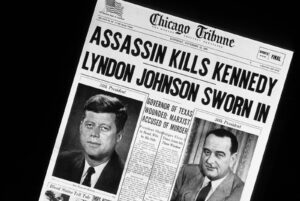Sunshine and breezy warm this early-evening Saturday here in California’s Central Valley — some light drizzle this morning, then a nice, easy day followed.
We are definitely easing into autumn.
Beyond the news of nowadays (shitty as it is), there’s a gem of an item from long, long ago — the assassination of JFK and the possibility of maybe a second shooter.
Boomers (as I am) love this shit:
A 60-year silence, broken. A Kennedy Secret Service agent’s revelation about a bullet he placed on JFK’s stretcher in Dallas. By James Robenalt @jimrobenalthttps://t.co/9oCDovPpK8
— David Friend (@DavidMFriend1) September 9, 2023
Noted attorney James Robenalt, also the author of four books, including, “Ballots and Bullets: Black Power Politics and Urban Guerrilla Warfare in 1968 Cleveland” (2018), interviewed Paul Landis, a former Secret Service agent who was guarding Jacqueline Kennedy in Dallas on Nov. 22, 1963.
Robenalt cracks the history mirror at Vanity Fair this afternoon — go read the whole piece if you can, It is really interesting and a jack-up for the Kennedy killing coming upon its 60th anniversary in November.
Main thrust:
As she did — standing up to follow Hill and another agent, Roy Kellerman, who lifted her husband’s body onto a gurney and raced into the hospital — Landis saw and did something that he has kept secret for six decades, he says now. He claims he spotted a bullet resting on the top of the back of the seat. He says he picked it up, put it in his pocket, and brought it into the hospital. Then, upon entering Trauma Room No. 1 (at that stage, he was the only nonmedical person in the room besides Mrs. Kennedy, and both stayed for only a short period), he insists, he placed the bullet on a white cotton blanket on the president’s stretcher.
This secret, as it turns out, may upend key conclusions of the Warren Commission, the body created by President Lyndon Johnson to investigate the assassination.
The sad fact is that Landis—though required to provide his version of events to the Secret Service (and, in a second report, to what would become the Warren Commission)—never sat for an interview before the FBI and never testified before the commission itself. He left the Secret Service months after the assassination and before the panel had finished its work and issued its report.
Landis, to this day, attests that in the first few years following the assassination, he was simply unable to overcome his PTSD from witnessing the murder firsthand. He says that the mental image of the president’s head, exploding, had become a recurring flashback. He maintains that he desperately tried to push down the memories. He also says he felt unable to read anything in detail about the assassination until some 50 years later, starting in 2014, when he began to come to grips with all that he had witnessed, suppressed, and finally processed.
And the time frame of Lee Harvey Oswald firing off three shots — nearly impossible:
Howard Willens, an assistant counsel to the Warren Commission, and the author of the 2013 book History Will Prove Us Right, wrote about this dilemma: “If the interval between the first and second shots covered a span of less than 2.25 seconds, the time estimated to be necessary for the assassin to fire two shots, it might suggest that a second rifle was involved.”
Further aspects via The New York Times, also this afternoon:
Mr. Landis’s account, included in a forthcoming memoir, would rewrite the narrative of one of modern American history’s most earth-shattering days in an important way. It may not mean any more than that. But it could also encourage those who have long suspected that there was more than one gunman in Dallas on Nov. 22, 1963, adding new grist to one of the nation’s enduring mysteries.
As with all things related to the assassination, of course, his account raises questions of its own. Mr. Landis remained silent for 60 years, which has fueled doubts even for his former Secret Service partner, and memories are tricky even for those sincerely certain of their recollections. A couple elements of his account contradict the official statements he filed with authorities immediately after the shooting, and some of the implications of his version cannot be easily reconciled to the existing record.
But he was there, a firsthand witness, and it is rare for new testimony to emerge six decades after the fact. He has never subscribed to the conspiracy theories and stresses that he is not promoting one now. At age 88, he said, all he wants is to tell what he saw and what he did. He will leave it to everyone else to draw conclusions.
Fascinating shit, especially from a boomer. One of our most special days — the shooting of Kennedy — is finally getting a new reaction, or whatever. History has always sought the low road.
A Grassy Knoll shooter, or not, yet here we are once again…
 (Illustration out front found here).
(Illustration out front found here).